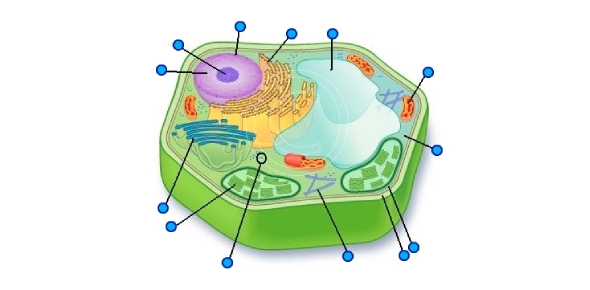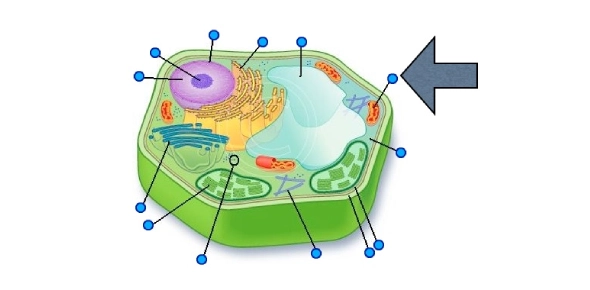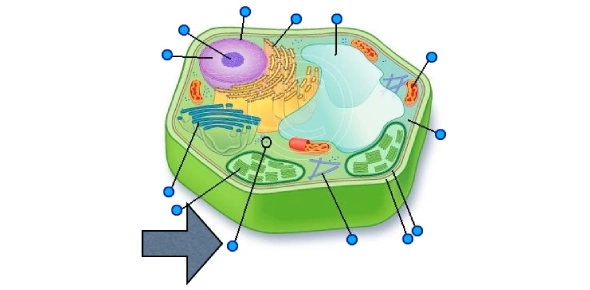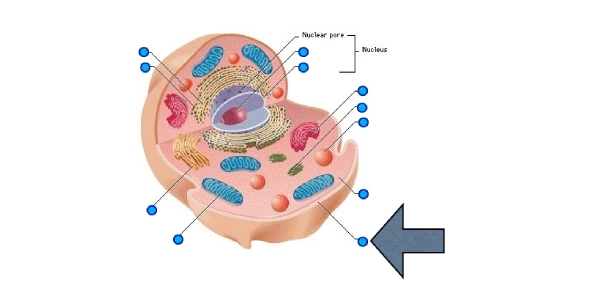Life Science Test 1

SCI06 Life Science Test 1
- 1.
Which of the follow is considered nonliving?
- A.
Water
- B.
Grass
- C.
Bacteria
- D.
Wood
- E.
Ants
Correct Answer
A. WaterExplanation
Water is considered nonliving because it does not possess the characteristics of living organisms. It does not have cells, does not grow, does not reproduce, and does not respond to stimuli. Water is a compound made up of hydrogen and oxygen atoms, and it exists in three states - solid (ice), liquid (water), and gas (water vapor). While it is essential for the survival of living organisms, water itself is not alive.Rate this question:
-
- 2.
Give an example of something living.
- 3.
Give an example of something dead.
- 4.
Name 3 characteristics that ALL living things share.
- 5.
What type of cell is this?
- A.
Animal
- B.
Plant
- C.
Human
- D.
Dog
- E.
Worm
Correct Answer
B. PlantExplanation
This cell is a plant cell because plants have unique cellular structures such as a cell wall, chloroplasts for photosynthesis, and large central vacuoles. These features are not present in animal, human, dog, or worm cells.Rate this question:
-
- 6.
The arrow is pointing to the dot that represents what part of the cell?
- A.
Chloroplast
- B.
Endoplasmic Reticulum
- C.
Lysosome
- D.
Mitochondria
- E.
Ribosome
Correct Answer
D. MitochondriaExplanation
The arrow is pointing to the dot that represents the mitochondria. Mitochondria are known as the powerhouses of the cell, responsible for producing energy in the form of ATP through cellular respiration. They have a distinct shape and are often depicted as small, dot-like structures within the cell.Rate this question:
-
- 7.
What is the FUNCTION of the part pointed to below? In other words, what does it do?
- A.
Supports the structure of the cell
- B.
Provides energy for the cell
- C.
Produces food for the cell
- D.
Controls what goes in and out of the cell
- E.
Gives the cell instructions
Correct Answer
B. Provides energy for the cellExplanation
The part pointed to in the question is responsible for providing energy for the cell. It is not involved in supporting the structure of the cell, producing food for the cell, controlling what goes in and out of the cell, or giving the cell instructions. Its main function is to generate energy that the cell needs to carry out its various processes and functions.Rate this question:
-
- 8.
The arrow is pointing to the dot that represents what part of the cell?
- A.
Ribosomes
- B.
Golgi Apparatus
- C.
Nucleolus
- D.
Cell Wall
- E.
Cytoplasm
Correct Answer
A. RibosomesExplanation
The arrow is pointing to the dot that represents ribosomes. Ribosomes are responsible for protein synthesis in the cell, and they can be found in the cytoplasm or attached to the endoplasmic reticulum. They are composed of RNA and proteins, and they play a crucial role in the production of proteins necessary for the cell's functions.Rate this question:
-
- 9.
What is the FUNCTION of the part pointed to below? In other words, what does it do?
- A.
Produces carbohydrates
- B.
Acts like a storage unit for the cell
- C.
Packages and distributes material throughout and out of the cell
- D.
Acts like the garbage disposal of the cell and processes waste
- E.
Controls what goes in and out of the cell
Correct Answer
E. Controls what goes in and out of the cellExplanation
The part pointed to in the question is most likely referring to the cell membrane. The cell membrane controls what goes in and out of the cell by acting as a selective barrier. It regulates the movement of molecules and ions, allowing certain substances to enter or leave the cell while preventing others from doing so. This function is crucial for maintaining homeostasis and ensuring the cell's proper functioning.Rate this question:
-
- 10.
Name two structures that plants and animals DO NOT SHARE.
- 11.
Which of the following IS NOT a primary chemical in cells?
- A.
Carbohydrates
- B.
Proteins
- C.
Lipids
- D.
Minerals
- E.
Nucleic Acids
Correct Answer
D. MineralsExplanation
Minerals are not considered primary chemicals in cells. While carbohydrates, proteins, lipids, and nucleic acids are all essential components of cells and play vital roles in various cellular processes, minerals are inorganic substances that are required in much smaller quantities for specific functions in the body, such as enzyme activation and maintaining osmotic balance. They are not considered primary chemicals because they are not directly involved in the structure or function of cells.Rate this question:
-
- 12.
Which of the TWO primary chemicals in cells provide cells energy? REMEMBER TO SELECT TWO.
- A.
Carbohydrates
- B.
Proteins
- C.
Lipids
- D.
Minerals
- E.
Nucleic Acids
Correct Answer(s)
A. Carbohydrates
C. LipidsExplanation
Carbohydrates and lipids are the two primary chemicals in cells that provide cells with energy. Carbohydrates are broken down into glucose, which is then used by the cells for energy production. Lipids, on the other hand, are stored in the body as fat and can be broken down to release energy when needed. Both carbohydrates and lipids play crucial roles in cellular energy metabolism.Rate this question:
-
- 13.
What is the difference between diffusion and osmosis?
- 14.
What is the difference between passive and active transport?
- 15.
Which of the following is an AUTOTROPH?
- A.
Fish
- B.
Butterfly
- C.
Tree
- D.
Shrimp
- E.
Rabbit
Correct Answer
C. TreeExplanation
An autotroph is an organism that can produce its own food through photosynthesis or chemosynthesis. Trees are autotrophs because they use photosynthesis to convert sunlight, water, and carbon dioxide into glucose, which is their source of energy. Fish, butterfly, shrimp, and rabbit are not autotrophs as they rely on consuming other organisms for their energy needs.Rate this question:
-
- 16.
Which of the following is a heterotroph?
- A.
Ant
- B.
Apple Tree
- C.
Flower
- D.
Grass
- E.
Wheat
Correct Answer
A. AntExplanation
Ant is the correct answer because a heterotroph is an organism that obtains its energy by consuming other organisms. Ants are consumers and obtain their energy by feeding on other organisms, such as dead insects, nectar, or plant sap. Apple trees, flowers, grass, and wheat are all autotrophs, meaning they can produce their own food through photosynthesis.Rate this question:
-
- 17.
We are unable to do photosynthesis, but how does photosynthesis give us energy?
- 18.
Why do we need cell division to occur?
Quiz Review Timeline +
Our quizzes are rigorously reviewed, monitored and continuously updated by our expert board to maintain accuracy, relevance, and timeliness.
-
Current Version
-
Dec 18, 2023Quiz Edited by
ProProfs Editorial Team -
Oct 12, 2009Quiz Created by
Wrosal
- Aeronautics Quizzes
- Aerospace Quizzes
- Agricultural Science Quizzes
- Astrology Quizzes
- Astronomy Quizzes
- Atom Quizzes
- Biochemistry Quizzes
- Biology Quizzes
- Biomechanics Quizzes
- Biostatistics Quizzes
- Biotechnology Quizzes
- Botany Quizzes
- Branches Of Science Quizzes
- Cytology Quizzes
- Easy Science Quizzes
- Ecology Quizzes
- Electrical Quizzes
- Embryology Quizzes
- Endocrinology Quizzes
- Epidemiology Quizzes
- Experiment Quizzes
- Forestry Quizzes
- Fossil Quizzes
- Gas Quizzes
- General Science Quizzes
- Genetics Quizzes
- Histology Quizzes
- Human Biology Quizzes
- Integrated Science Quizzes
- Invention Quizzes
- Library Science Quizzes
- Lighting Quizzes
- Liquid Quizzes
- Marine Biology Quizzes
- Microbiology Quizzes
- Molecular Biology Quizzes
- Nature Quizzes
- Neuroscience Quizzes
- Nuclear Science Quizzes
- Oceanography Quizzes
- Physics Quizzes
- Psychology Quizzes
- Science And Technology Quizzes
- Science Glossary Quizzes
- Science Knowledge Quizzes
- Science Practice Quizzes
- Scientific Method Quizzes
- Scientific Notation Quizzes
- Soil Science Quizzes
- Solar System Quizzes
- Solid Quizzes
- Zoology Quizzes
 Back to top
Back to top







